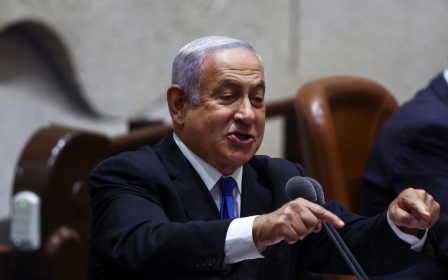Israel's new prime minister to move into pre-Nakba Palestinian house

Israel's new prime minister will be moving to a Palestinian house in Jerusalem whose owners were expelled during the 1948 Palestinian Nakba.
Yair Lapid, who took over the premiership in a caretaker capacity on Thursday, will move into Villa Hanna Salameh temporarily while construction work is carried out at the prime minister's official residence in Jerusalem, located on the same Balfour Street.
The house was built in the 1930s by Hanna Salameh, a Palestinian businessman who was forced out during the Nakba, or "the catastrophe", the name Palestinians give to the massacres and forced expulsion they endured at the hand of Zionist militias in 1948.
The house was seized by the Israeli government under the Absentees' Property Law, which grants the state the power to confiscate and impound Palestinian properties and assets that they were forced to leave behind in 1948.
Two previous Israeli prime ministers, David Ben-Gurion and Levi Eshkol, refused to live in Palestinian properties seized under the absentees' law, making Lapid's decision an anomaly in Israeli politics.
New MEE newsletter: Jerusalem Dispatch
Sign up to get the latest insights and analysis on Israel-Palestine, alongside Turkey Unpacked and other MEE newsletters
The house, still marked "Villa Salameh" at its entrance, was previously used by Israeli marines and later housed the Guatemalan embassy in Israel.
Jihad Abu Raya, a Haifa-based Nakba researcher and lawyer, said Lapid's decision is another reminder of Israel's crimes against Palestinians.
"After expelling Palestinians and committing massacres in their villages and towns, the Israeli [state] then moved on to take over their houses, factories, shrines, cemeteries, mosques and so on," said Abu Raya.
"It acted not as custodian of such properties, but as thieves and looters."
Absentees' law
The Absentees' Property Law was issued in 1950 to help the newly founded state of Israel find the legal framework to deal with swathes of land and thousands of properties in more than 500 towns where Palestinians had lived.
During the Nakba war, referred to as the war of independence in Israel, 80 percent of the Palestinian population was forcibly expelled to make way for the state of Israel.
Zionist gangs indiscriminately killed unarmed civilians and buried some in mass graves during the military campaign.
The raids, which began in late 1947, continued well after Israel announced independence on 15 May 1948.
The Israeli campaign left an estimated 15,000 Palestinians dead and some 750,000 were displaced as a result.
The absentees' law allowed the Israeli government to also seize Palestinians' assets - including cash, stocks, furniture, books, companies, banks, and other movable assets.
These lands and properties lie in modern-day Israel. Their original owners are primarily refugees, but some are internally displaced and now living in Israel.
Talbiya neighbourhood
Salameh's villa was among the properties taken over under the Absentees' Property Law.
Located in the Talbiya neighbourhood, the house was designed by Jewish architect Zoltan Harmat and built in 1932. The owner Hanna Salameh was forced to move to Lebanon in 1948 and never allowed to return.
The house is often confused with another building constructed before 1948 by another Palestinian named Constantine Salameh.
Constantine, a prominent Palestinian entrepreneur who died in Beirut in 1990 at the age of 103, leased the house to the Belgian consulate in Jerusalem, which refused for decades to pay rent to the State of Israel, insisting that Constantine was the rightful owner, according to Abu Raya.
In the same neighbourhood, another house owned by Hanna Bisharat was the centre of controversy in the past.
Bisharat's house, previously known as Harun ar-Rashid villa, was occupied by the country's fourth prime minister Golda Meir when she served as the foreign minister between 1956 and 1966.
Middle East Eye delivers independent and unrivalled coverage and analysis of the Middle East, North Africa and beyond. To learn more about republishing this content and the associated fees, please fill out this form. More about MEE can be found here.




